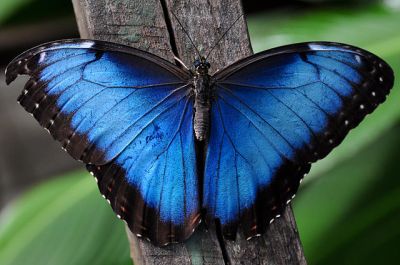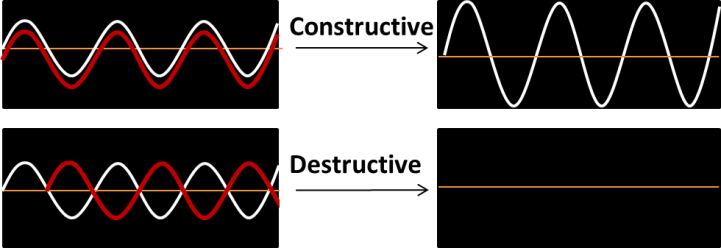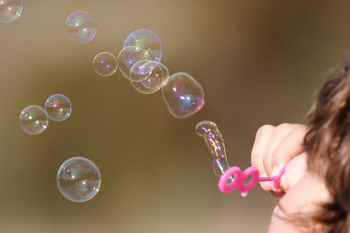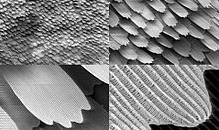Have you ever wondered where the inspiration behind new technologies comes from? We don’t have to go too far to find out; it is enough to just look out the window!
Look deep into nature, and then you will understand everything better.
-Albert Einstein
Yes, nature is out there, standing as a giant laboratory of science and engineering!1 For centuries now, we have been trying to understand nature’s strategies and apply what we learn from them to solve our modern problems. One of our previous posts, “Nature’s nanotechnology, bio-mimicry, and making the superpowers of your dreams a reality,” discusses various nature-inspired solutions to these daily problems. It is really fascinating to realize that scientists are inspired by shark skin, flower leaves or butterfly wings! In this post, we’re going to dig a little deeper into the science behind one of these: let’s explore the science behind the striking colors of butterfly wings and how imitating them has helped us to develop anti-counterfeit technologies.

One of the largest butterflies in the world, the blue morpho butterfly outshines others with its vivid blue color. Contrary to popular belief, it is not pigments that give the wings their bright color. In fact, the wings consist of thousands of transparent structures. But if the material of the wings is transparent, then where do the colors come from?
You might have an idea about the answer if you ever blew soap bubbles with a wand when you were a child.2 Remember how the bubbles change color when the light shines onto them? This effect is all about how light waves interact with each other. The surface of a bubble is a thin film of soap, and when light travels from its source and bounces off the bubble on its way to your eye, the light waves reflecting from the inner and outer surfaces of this thin film interfere with each other. The interference occurs when two light waves meet, and it can be either constructive or destructive. If the two waves sync so that they are exactly on top of each other, their intensities add up to form a bigger wave (constructive). But if a peak coincides with a dip, then they cancel each other out (destructive).

While the constructive interference creates more intense colors, the destructive interference results in weaker colors or none at all.
Since one wave has to travel a longer distance passing into the interior surface of the soap film compared to another reflecting from the outer surface, the waves will meet each other slightly out of sync. The interference pattern will alter depending on how much extra distance the light travels into the film before reflecting (in other words, how thick the wall of the soap bubble is). What we see as a result is differentiating colors under the sun! This effect is called iridescence.

Keep in mind that the thickness of the film, the angle of the light wave hitting the surface and the viewing angle all influence this rainbow effect. Check here for more on why bubbles are colored.
Just like the colored soap bubbles, butterfly wings appear bright blue due to the constructive interference of light waves. Their wings consist of many air-sandwiched layers of nano-scale structures, kind of like fish scales.3 When the light hits these equally spaced layers, the numerous reflections create constructive interference patterns resulting in our eye perceiving very intense colors. The tiny structures also contribute to the selection of colors by only reflecting certain wavelengths. Depending on the shape, size, angle and spacing of the structures, certain colors are selectively canceled out or strengthened, giving the blue/brown colors to the wings.

The blue morpho butterfly, playing this light game with the tiny structures on its wings, inspired a new security technology created by scientists at Simon Fraser University. By using the light diffraction properties of butterfly wings as its inspiration, NanoTech Security Corporation built materials with nano-sized holes to create the same effect. This so-called “Butterfly Effect” aims to fight forgery in currency, IDs, passports and many consumer products. Rather than the color deriving from the material itself, the way light reflects off the nano-arrays of holes is the source of the color here. When light shines onto these arrays of holes, the interference pattern of the light waves leads to a unique image. What is more exciting is that the colors of the images can be tuned by just the geometry and the number of these holes. The template for the holes is made by a technique called electron beam lithography, which is also used to make prototype computer chips. This technique is capable of creating very small surface structures, and it is suitable to insert these patterns into many different surfaces such as glass, plastic, metals or paper, changing the color that we see without the need to add dye or coating to the material.
Creating visual images with enriched colors without the use of any dyes or chemicals makes it harder to counterfeit bank notes because it’s much harder to fake nanoscale features than the micro-scale images currently used on most currency. This technology is also appealing to use in the pharmaceutical industry. Imagine that an array of tiny nano-scale holes with the required geometry was inserted onto pills or capsules — the resulting unique bright images would allow you to directly identify whether the pill was genuine or not!
Nature is full of solutions to many of the challenges we encounter. Imitation may not be the sincerest form of flattery, but biomimicry opens up a wide variety of new opportunities for technological advancement.
WANT MORE INFORMATION?
Here’s a TEDx talk about this technology by Clint Landrock from NanoTech Security Corp.
1. Bar-Cohen, Y. Nature as a Model for Mimicking and Inspiration of New Technologies. Int’l J. Aeronautical& Space Sci. 2012, 13(1),1-13. DOI:10.5139/IJASS.2012.13.1.1 or PDF
2. http://animals.howstuffworks.com/insects/butterfly-colors.htm
3. Yoshioka, S.; Kinoshita, S. Wavelength-selective and anisotropic light-diffusing scale on the wing of the Morpho butterfly. Proceedings: Biol. Sci. 2004, 271(1539): 581-587. DOI:10.1098/rspb.2003.2618 or PDF

[…] Para leer el blog original en inglés, presione aquí. […]